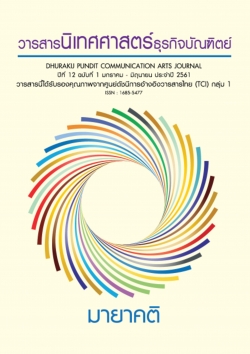ภาพยนตร์กับทฤษฎีแห่งความบันเทิง
คำสำคัญ:
ภาพยนตร์, ความบันเทิงบทคัดย่อ
แม้ภาพยนตร์เป็นผลิตภัณฑ์แห่งความบันเทิง ทฤษฎีว่าด้วยความบันเทิงไม่เป็นที่ถกเถียงในศาสตร์ด้านภาพยนตร์มากนัก ความเข้าใจภาพยนตร์บันเทิงในช่วงที่ผ่านมาจึงอิงรูปแบบการผลิตมากกว่าอื่นใด เช่น ใช้นักแสดงระดับดารา มีเงินลงทุนขนาดใหญ่ มีความชัดเจนในแง่ตระกูลภาพยนตร์ ฯลฯ ลักษณะความเข้าใจเช่นนี้นำไปสู่คำอธิบายแก่นสารในมิติทางธุรกิจ
หากตีความตามหลักอักษรศาสตร์ ภาพยนตร์บันเทิงคือภาพเคลื่อนไหวที่มุ่งสนองตอบต่อความต้องการบันเทิงเริงรมย์ของผู้ชม ทว่าความบันเทิงในบริบทนี้กลับไม่ใช่ความสนุกสนานทั่วไปแต่มีความลึกซึ้งในทางจิตวิทยา เพราะเป็นภาวะความพึงพอใจอย่างหนึ่งหลังจากได้รับการปรุงแต่งทางอารมณ์ให้รู้สึกโกรธ ตื่นเต้น ประทับใจ เศร้า หรืออื่นๆตามแต่จะชักนำโดยเนื้อหาเรื่องราว ความพึงพอใจนี้เกิดขึ้นในขั้นตอนซึ่งรู้จักกันในภาษาอังกฤษว่า “meta-emotion” ดังนั้นภาพยนตร์บันเทิงจึงเป็นงานที่มุ่งสนองตอบต่อความคาดหวังทางอารมณ์ของผู้ชม เมื่อผู้ชมมีอารมณ์คล้อยตามแล้ว จะปล่อยตนเข้าสู่เนื้อหาเรื่องราวที่กำลังรับชมจนกลายเป็นอรรถรสทางจินตนาการ และนี่คือเหตุผลว่าทำไมภาพยนตร์ได้รับการกล่าวขานว่าเป็นงานมายา กรณีศึกษาต่างๆรวมทั้งผลงานของไทยเรื่อง ฉลาดเกมส์โกง และ 9 ศาสตรา คือแบบอย่างแห่งความบันเทิงสำหรับผู้ชมยุคปัจจุบัน กรณีเหล่านี้ช่วยฉายให้เห็นว่าการออกแบบภาพ-เสียง รวมทั้งการสร้างสรรค์บทล้วนเป็นไปเพื่อให้เกิดผลทางอารมณ์
เอกสารอ้างอิง
วิทยาการจัดการ มหาวิทยาลัยราชภัฎเชียงราย, 6(1), 21-50.
2. ข่าวไทยพีบีเอส. (2560). ปี 2560 หนังไทยยังน่าเป็นห่วง. กรุงเทพฯ: ไทยพีบีเอส.
3. ไทยรัฐ. (2558, 21 สิงหาคม). วิกฤติหนังไทยซบเซา ผู้สร้างถอดใจ?!, ภาพยนตร์ไทย. สืบค้นจาก
https://www.thairath.co.th/content/519593
4. ไทยรัฐ. (2559, 12 เมษายน). "หลวงพี่แจ๊ส 4G" แรงจริง วันแรกกวาดรายได้ทะลุ 50 ล้าน.
สืบค้นจาก https://www.thairath.co.th/content/604534
5. ไทยรัฐ. (2559, 22 มกราคม). จุดแข็งอาเซียน 'ผีไทย' ชูโรง! 'เวียดนาม' เรียนจาก 'เกาหลี' ไล่กวด 'หนัง
ไทย'. สืบค้นจาก https://www.thairath.co.th/content/566223
6. พฤทธิ์ ศุภเศรษฐศิริ. (2555). ภาพยนตร์ตลก : กรณีศึกษาภาพยนตร์ตลกของไทยในช่วงปี 2548-2552.
กรุงเทพฯ: วิทยาลัยนวัตกรรมสื่อสารสังคม มหาวิทยาลัยศรีนครินทรวิโรฒ.
7. ภาวิณี กาญจนาภา. (2559). พฤติกรรมผู้บริโภค. กรุงเทพฯ: สำนักพิมพ์มหาวิทยาลัยศิลปากร.
8. ราชบัณฑิตยสถาน. (2561, 10 กุมภาพันธ์). พจนานุกรม ฉบับราชบัณฑิตยสถาน พ.ศ. ๒๕๕๔. สืบค้นจาก http://www.royin.go.th/dictionary/lookup_domain.php
9. Bartsch, A., & Viehoff, R. (2010). The Use of Media Entertainment and Emotional Gratification.
Procedia Social and Behavioral Sciences, 5, pp. 2247-2255.
10. Bates, S., & Ferri, A. J. (2010). What's Entertainment? Notes Toward a Definition. Studies in
Popular Culture, 33(1), pp.1-20.
11. Dow, G. (2017). Codes and Conventions of the Romance Genre. Retrieved 28 February 2018,
from https://prezi.com/thwwuf9t8fjk/codes-and-conventions-of-the-romance-genre/
12. Ecophon. (2017). Impact of Noise in Healthcare: A Research Summary. Samrand: Saint-
Gobain.
13. Hall, S. (2011). Blockbusters. New York: Oxford University Press.
14. Hartman, K. (n.d.). A Summary of the Book Save The Cat: The Last Book on Screenwriting that
You´ll Ever Need By Blake Snyder.
15. Hauge, M. (2005). Michael Hauge’s Six Stage Plot Structure.
16. Hauge, M. (2014). Story Structure: The 5 Key Turning Points of All Successful Screenplays.
17. Michael Hauge: Story Master. Retrieved 1 March, 2018, from https://www.storymastery.com/story/screenplay-structure-five-key-turning-points-successful-scripts/
18. Hayward, S. (2006). Cinema Studies: The Key Concepts. London: Routledge.
19. Hooli, S. H. (2015, 15 July). 'Baahubali' Draws Foreign Media Attention; Is it Time for SS Rajamouli to Debut in Hollywood? International Business Times. Retrieved from http://www.ibtimes.co.in/baahubali-draws-foreign-media-attention-it-time-ss-rajamouli-debut-hollywood-639331
20. Hornby, A. S. (Ed.) (2005) Oxford Advanced Learner's Dictionary of Current English. Oxford:
Oxford University Press.
21. Kim, H. W. K. (2018). Could K-Film Ever Be As Popular As K-Pop In Asia? Forbes. Retrieved 1 March, 2018, from https://www.forbes.com/sites/outofasia/2018/01/11/along-with-the-gods-could-k-film-ever-be-as-popular-as-k-pop-in-asia/#7a724fa63594
22. Lee, E. (2016, 29 September). Train to Busan Becomes Top-Grossing Asian Film in Hong Kong History, Passing Cold War 2. South China Morning Post. Retrieved from http://www.scmp.com/culture/film-tv/article/2023586/train-busan-passes-cold-war-2-become-top-grossing-asian-film-hong
23. Mayer, J. D., & Gaschke, Y. N. (1988). The Experience and Meta-experience of Mood. Journal
of Personality and Social Psychology, 55, pp.102–111
24. Ritterfeld, U. (2004). Enjoyment: At the Heart of Media Entertainment. Communication Theory, 14(4), pp. 388–408.
25. Nielsen, J. I. (2007). Camera Movement in Narrative Cinema - Towards a Taxonomy of
Functions. Aarhus: Department of Information & Media Studies, Faculty of Arts,
University of Aarhus.
26. Oliver, M. B. (1993). Exploring the paradox of the enjoyment of sad films. Human
Communication Research, 19(3), pp. 315-342.
27. Prabhakar, B. (2014, 26 October). India Is a Very Important Market for Hollywood Movies: Frank
Rittman, MPAA The Economic Times. Retrieved from https://economictimes.indiatimes.com/opinion/interviews/india-is-a-very-important-market-for-hollywood-movies-frank-rittman-mpaa/articleshow/44934819.cms
28. Prokop, P. (2016). Universal Human Fears. In T. K. Shackelford & V. A. Weekes-Shackelford
(Eds.), Encyclopedia of Evolutionary Psychological Science. Cham: Springer International Publishing. Switzerland
29. Redfern, N. (2012). Correspondence Analysis of Genre Preferences in UK Film Audiences.
Participations: Journal of Audience and Reception Studies, 9(2), pp. 45-55.
30. Reinecke, L. (2017). Mood management. In P. Rössler (Ed.), The International Encyclopedia of
Media Effects, pp. 1271-1284. Wiley-Blackwell.
31. Rotten Tomatoes. (2016). Captain America: Civil War. Marvel Cinematic Universe. Retrieved 1
March, 2018, from https://www.rottentomatoes.com/m/captain_america_civil_war/
32. Statista. (2018). Distribution of Films Screened in Cinemas in South Korea from 2004 to
November 2017 by Origin. Retrieved 1 March 2018, from Statista GmbH https://www.statista.com/statistics/625516/south-korea-market-share-films-domestic-foreign/
33. Suraj, H. (2016). Golden Light. Retrieved 28 February, 2018, from
https://reikirays.com/32860/golden-light/
34. Szabo, C. (2010). Independent, Mainstream and In Between: How and Why Indie Films Have
Become Their Own Genre. New York: Pace University.
35. The BFI Research and Statistics Unit. (2016). Genre and Classification. London: BFI.
UNESCO Institute for Statistics. (2016). Diversity and the Film Industry: An Analysis of the 2014
UIS Survey on Feature Film Statistics. Quebec: UNESCO-UIS.
36. Vorderer, P., Klimmt, C., & Ritterfeld, U. (2004). Enjoyment: At the Heart of Media Entertainment.
Communication Theory, 14(4), pp. 388–408.
ดาวน์โหลด
เผยแพร่แล้ว
ฉบับ
ประเภทบทความ
สัญญาอนุญาต
ลิขสิทธิ์เป็นของวารสาร....




